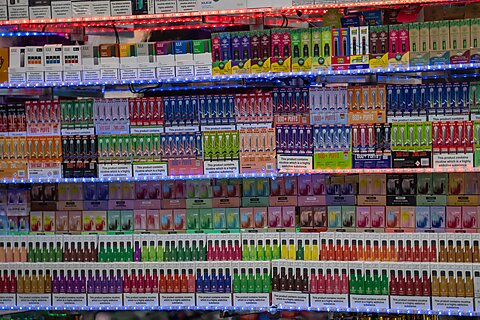
E-Cigarettes Are Not Exempt from the Iron Law of Prohibition
The New York Times reports today about a flood of illicit e‑cigarettes arriving from China “in Barbiecore colors and fruit, ice cream and slushy flavors,” accounting for a “major share of the estimated $5.5 billion e‑cigarette market in the United States.” This “never‐ending influx of vapes” comes despite the Food and Drug Administration authorizing only a handful of e‑cigarettes for sale to persons over age 21.
The Times reports that many of these vapes contain 5,000 or more puffs per device and have nicotine levels that sometimes exceed those in tobacco cigarettes. Many are being sold in convenience stores even though the FDA has sent them warning letters threatening store owners with fines as high as $19,000 per violation.
The goal of policymakers and the FDA was to curtail the use of flavored vapes. Many states and some cities have enacted bans on in‐store and/or online sales of flavored vapes.
According to the CDC, these prohibitionist efforts have backfired, resulting in a surge in flavored vape sales, from 11 million per month in early 2020 to 18 million per month in June 2023.
The Times reports that seven years since Congress granted the FDA regulatory authority over e‑cigarettes in 2016, 40 percent of e‑cigarette users are 25 or younger. And while the FDA has authorized only a couple of dozen e‑cigarette products, vapers find access to more than 2,000 of them. The Times article states:
There are few places where the problem feels more pressing than in high school bathrooms, where students crowd the stalls between classes to get a nicotine fix.
Nevertheless, teen vaping rates have fallen from their peak of 28 percent in 2019 to roughly 14 percent in 2022.
The failure of e‑cigarette prohibition was predictable—as is the advent of more potent and puff‐packed forms of nicotine vapes now sold on the black market. Though prohibitionists never seem to learn, the “iron law of prohibition” is inescapable. A variant of what economists call the “Alchian‐Allen Effect,” put simply, the iron law states, “the harder the law enforcement, the harder the drug.”
Prohibition incentivizes purveyors of prohibited substances to find more potent forms of the banned substance so it can be smuggled in smaller sizes and subdivided into more units to sell. During alcohol prohibition, for instance, bootleggers smuggled whiskey and other hard liquors, not beer or wine.
The iron law of prohibition is why cannabis THC concentration has grown over the years. It is what brought crack cocaine into the cocaine market. And it made fentanyl replace heroin as the primary cause of overdose deaths in the United States.
In the 21st century, law enforcement’s crackdown on diverted prescription opioids (the drug of choice for nonmedical users at the time) led to their replacement with heroin. By 2012, heroin dealers began adding the synthetic opioid fentanyl to heroin so they could smuggle it in smaller sizes and subdivide it into more units to sell. By 2016, fentanyl‐related deaths eclipsed deaths from heroin and diverted prescription pain pills. By 2017, fentanyl was found in more than 50 percent of opioid‐related overdose deaths. By 2022, it was involved in roughly 90 percent of deaths.
Policymakers are now discovering that tobacco and e‑cigarette bans are not exempt from the iron law. Whether these prohibitionists reverse course before causing more harm remains to be seen.



